
For people obsessive about style, 2010 is remembered as the height of “#menswear,” a nickname – sometimes pejorative – derived from when Tumblr editors could tag photos with the menswear hashtag for higher visibility. It was a time when tailored clothing, workwear, and other heritage styles dominated online conversations about men’s style. Magazine editorials and short blog entries breathlessly repeated the same phrases, such as “buy less, buy better,” encouraging men to be more thoughtful about their wardrobe purchases. As men flocked to stores to buy Goodyear welted shoes and fully canvassed suits, many felt they were investing in a wardrobe they could wear for a lifetime.
As time marched on, things changed. Some found their tastes developing in unexpected ways. Others needed to rebuild their wardrobe because of changes in their circumstances – a change in their job or city, or a global pandemic that forced them to work from home (sometimes in the same office, but more casually attired).
Since many people in 2010 thought they were “buying it for life,” we were curious to know what has stuck around. So we asked some key menswear figures who were around during that #menswear era to see what from 2010 they still have in their wardrobe. What makes that item special to them? How often do they wear it? And what do they plan to do when that item finally wears out? This is the second part of our two-part series. The first part was posted last week.
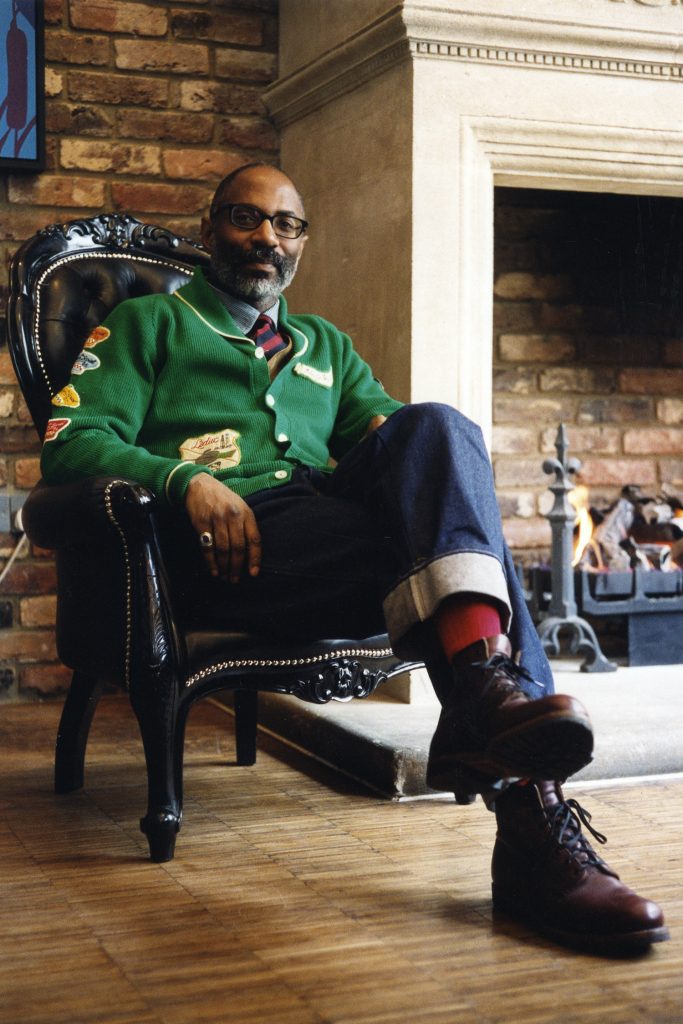
Photo by Marcus Agerman Ross
Jason Jules, Creative Director, Author, Brand Architect, and Menswear Consultant
Jason Jules, the author of the newly released book Black Ivy, has such a striking sense of style, his fit pics have caught the eye of many online. But fifteen years ago, it was a piece of clothing that caught his eye when he was at a magazine photoshoot in Amsterdam. “It was a Carhartt hickory-striped work shirt, given to me by the brand for this photoshoot,” he says. “I wore a bunch of other brands for this shoot, but this is the one piece I asked if I could keep.”
The shirt’s quality stood out to Jason. “I liked its simplicity and its ruggedness. This was a solid piece of workwear but with an upgraded finish. It had the same quality as the vintage workwear pieces I dreamed of finding back then.”
Jason found that he continued to wear the shirt in subsequent shoots. “This picture was taken 15 years ago for an early issue of Jocks and Nerds Magazine. The founder and editor, Marcus Agerman Ross, took the shot. I’m sitting in what was then my second home — the lobby of the Horton Hotel in Shoreditch. That’s how I dressed back then, only more so since it was for a shoot.”

Since then, Jason has found that, while his style has slightly changed, his taste has not. “I still like to mix workwear with other forms of clothing – sportswear, formalwear, you name it. I still like to mix vintage with newer pieces, and I like to play with proportion and layering.”
It’s not surprising that his Carhartt shirt still gets a fair amount of wear, at least when it’s not in storage. “I may travel abroad for six months of the year and leave it in the UK. I like coming back to a place where I’ve stored some of my clothes and being reunited with them.”
“It’s never occurred to me to replace or get rid of it. It’s super versatile and simple and has done nothing to offend me in terms of being over-designed or falling apart. So it’s just here, as another part of the ever-growing jigsaw I call my wardrobe.”
Jason also found that the shirt has held up well over the years. “The shirt hasn’t aged that much. I anticipated that it would get softer texture-wise or its color would fade a little, but neither has happened.” But even when the shirt begins to show its age, he’ll continue to wear it. “I like it when old clothes look old and show their age. I would probably still wear it if it got damaged somehow or the collar started fraying. Unless it was badly damaged and beyond repair, I’d have to store it away. I rarely throw anything away. I wouldn’t try and replace it; that’s not how it works for me.”

Sid Mashburn, Owner of Sid Mashburn
When Sid Mashburn looks inside his closet, he can find clothes he’s had for over twenty years. “I’m not a man of many clothes,” he says. “It’s not like I don’t have a pretty good selection, but my wardrobe isn’t as large as some might assume. When I buy something, I tend to pick and stick.”
One item that sees a lot of wear is the first suit, a navy high twist, that his store designed. “I worked with our master tailor Quang Dau to develop our suit model,” Sid explains. The jacket hits all the right notes: natural shoulder, full canvas, two-button front, side vents, front darts, welted out-breast, and flap pockets with a ticket pocket. The plain front trousers are slim, but not skinny, and complement the silhouette of the accompanying jacket.
Sid is especially fond of the fabric, which he wears year-round in Atlanta. “It’s timeless. We worked to get this particular fabric, which is made in England.” The fabric is a type of tropical wool, which is woven from yarns that have been given an extra twist during the spinning process. This extra-twist – called high-twist in the fabric industry – gives the resulting yarns a bit of extra strength, resilience, and tension, which allows weavers to make porous, open-weave wools that breathe well during the summer. It’s also naturally resistant to wrinkles, making it ideal for travel.
“I went to a wedding on what we affectionately call the Redneck Riviera, which is the panhandle of Florida. It’s boiling there, and this is July, and here I’ve got something over 300 grams, so it’s not light. As a matter of fact, it’s got some heft to it. But the weave of the fabric breathes so well. Some people there were sweating through their linen and cotton garments. I didn’t sweat at all. It was a bit of a Eureka moment for me to see how it performed.”
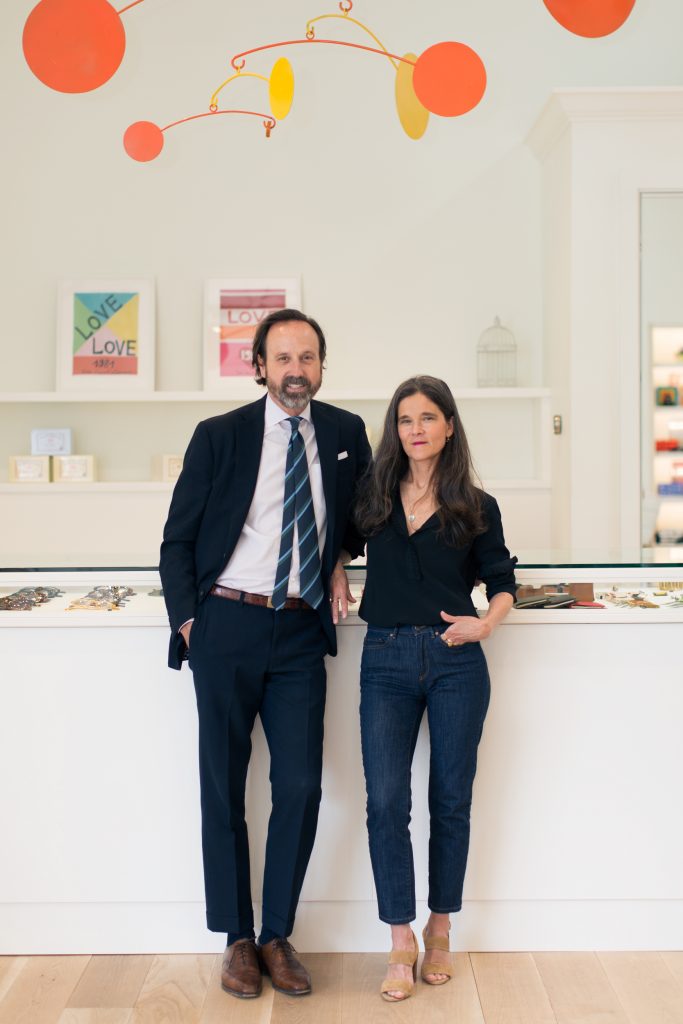
Despite having clothes older than his store, Sid still manages to find ways to let things go. “Every suit that I’ve bought since the ‘90s, there’s not a single one where I don’t still like the fabric. So really, it’s the cut that’s changed. It’s a constant process of refining the cut, understanding that the shoulder was a bit too hard, the lapel could have been wider, the notch at the wrong height, or that it should have been a two-button instead of three. We’ve got the cut down to where I really, really like it now.”
Sid’s navy high-twist suit stands to weather trends. The suit is designed with Goldilocks proportions: a jacket that is short but not too short and lapels that perfectly meet the midpoint between the collar and shoulder. “I can’t think of anything else that’s particularly distinctive about it, except for the thing wears like iron. I love to wear it, and every time I wear it, people comment ‘that a beautiful jacket’ or ‘that’s a beautiful fabric.’”
Having owned this suit for so long, Sid has found various ways to wear it. For casual events, he dresses it down with a white, long-sleeved polo and tassel loafers. For more formal occasions, he’s found that the suit looks so elegant with a navy grenadine tie and white shirt, it can almost serve as a replacement for black tie.
“It really is the everyman’s suit. When someone comes in, and if they don’t have something like it, we typically send them to it. We’ve been running it since 2010ish, and we’re still running it today, and its appeal has not diminished. It’s even got more popular.”

Jeremy Kirkland, Host of Blamo!
“I’m one of those people that freaks out a little whenever I get something new,” Jeremy Kirkland, host of Blamo!, admits. “Like, this thing has to marinate in the wardrobe a bit before I bust it out. And then when I do wear it, I’m so scared I might stretch out the collar or stain the fabric!” But Jeremy makes an exception for his Engineered Garment workshirt. “I’ve owned it for so long; I don’t care what happens to it. It’s just bulletproof.”
Jeremy bought the shirt in 2010 from Drinkwater’s, a high-end menswear shop based in Cambridge, Massachusetts. “The shop’s owner and namesake, Gary Drinkwater, used to post photos of his seasonal buys on StyleForum,” Jeremy remembers. “The funny thing is, I was living in New York City at the time but didn’t know how to purchase an Engineered Garments shirt. Some people forget that, back then, Engineered Garments didn’t allow stockists to sell their clothes online. The only way to circumvent this policy was by calling up a store. I remember feeling like it was a huge pain to call this shop in Massachusetts, get measurements, and compare those measurements against things I already own. But once I got the shirt, I wore the hell out of it. The collar is a little faded nowadays, but the shirt has held up remarkably well for how much I’ve worn it.”
Jeremy’s shirt is a two-pocket, double-needle, chambray workshirt style popular during the late aughts, when heritage menswear was ascendant. Even as Jermey’s sense of style has evolved over the last decade, he’s always found ways to incorporate this Engineered Garments piece. “It worked when I was trying to do Cool Guy Workwear, and it worked when I was trying to do Cool American-Italian sort of stuff. I’ll wear it with chinos, denim, and Ambrosi trousers. It’s just kind of perfect. I don’t think it represents one particular thing on its own, which is why it’s so versatile.”
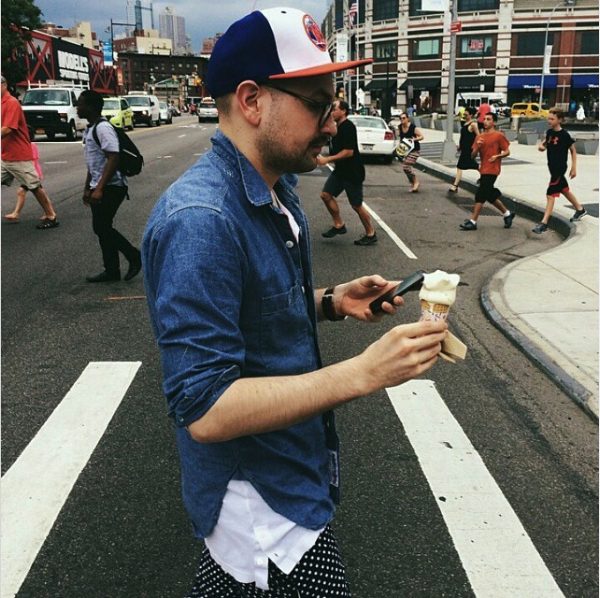
Although Jeremy has thought about getting rid of the shirt a few times, possibly selling it on secondary markets such as Grailed or eBay, he’s never been able to let it go. “To be honest, I never really got around to it because Engineered Garments workshirts don’t resell for very much. It’s a perennial item in their collections, so it’s not very difficult to find. I always figured it wasn’t worth my time to list it.” But as time went on, the shirt’s sentimental value began to grow, and even Jeremy hasn’t been able to find suitable replacements. Newer versions come with slightly different details and silhouettes, never quite matching the personal value of his original.
“I don’t think I could ever find a replacement for this, at least not in the way I’d want. I remember bringing it with me to Vegas during one trip and cruising around the desert with it. I was definitely not babying the shirt, but then I realized at some point, ‘oh wait, what if I ruin this sentimental shirt of mine?’ So now I feel like I’ve gone full circle, where I’m wondering if I should treat it more preciously.”
Thankfully, the brief relapse into caring too much about one’s clothes quickly passed, and Jeremy feels the shirt has taught him to wear his purchases. “I’ll probably wear this one into the ground,” he says. “When people say they’re buying something expensive so they can pass it onto their kids, I think they’re full of shit. Most of us should be so lucky to wear something twenty or thirty years from now. And anyways, clothes naturally break down. Except for maybe outerwear, you can’t love something and make it last forever. The real joy comes from wearing your clothes, not preserving them.”
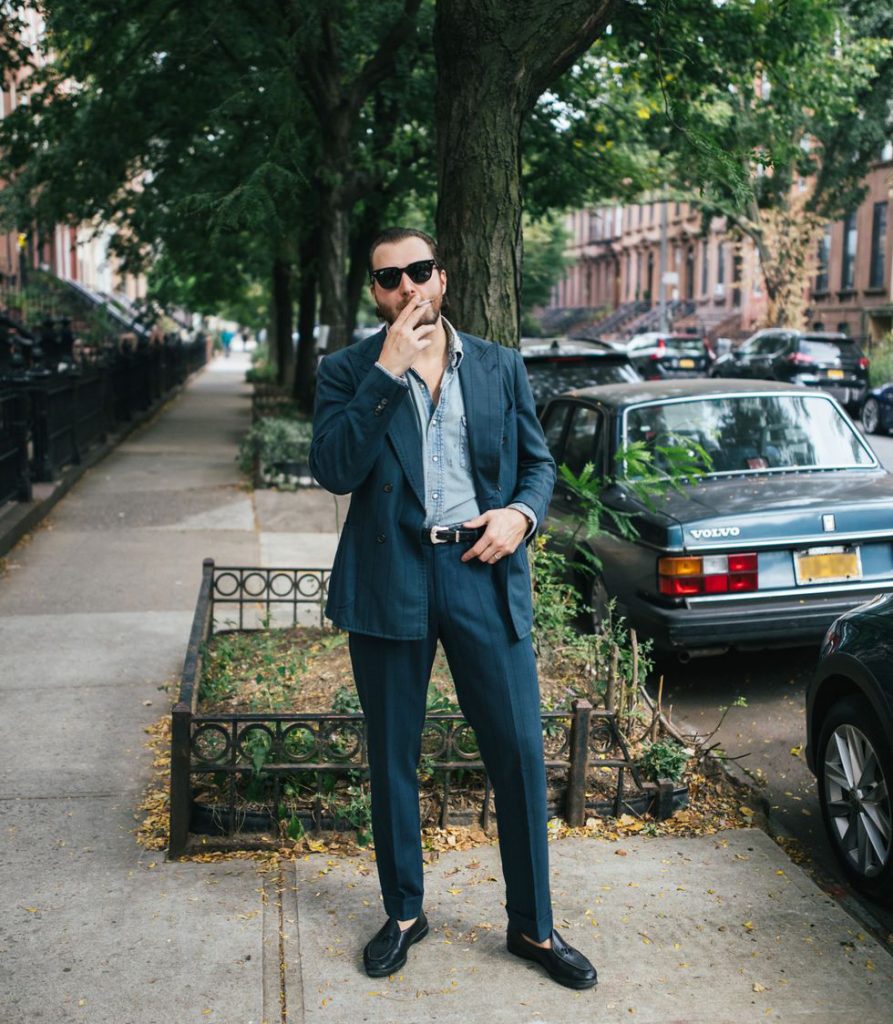
Photo by Christopher Fenimore
Lawrence Schlossman, Co-Host of Throwing Fits
Twelve years ago, Lawrence Schlossman, co-host of Throwing Fits, was a blogger behind the influential menswear Tumblr account, How to Talk to Girls at Parties. The site was a combination of him posting photos and answering readers’ questions, and things he posted quickly turned into micro-trends in the hashtag menswear scene. “I still have a lot of the things I wore from that era, which obviously includes a lot of tailoring,” he says. “It’s funny, I was never a huge suit guy. I loved the idea of suits, but I mostly wore sport coats. However, I still have one suit from that era that I still wear: an Isaia double-breasted that I bought like all of my other Isaia stuff, at a sample sale.”
As something of a micro-influencer during that era, and a friend of Agyesh Madan, a former Isaia employee who now heads Stoffa, Lawrence was invited to Isaia sample sales. “Those Isaia sample sales were the first samples sales that I got invited to. I remember thinking it was a crazy badge of honor, like, ‘wow, I’m worthy of being invited to spend my money.”
“I remember seeing this beautiful double-breasted suit that was supposedly dyed with actual blueberries. It ticked all the right boxes: huge peak lapels, interesting fabric, double-breasted. I think I paid $750 for it. At the time, I was working as a PR associate, which was my first fashion job. It was a huge financial stretch for me, and I remember debating on whether I should pull the trigger.”
In the beginning, Lawrence loved this suit so much that he wore it once a week, in his words, “for no reason.” (“I mean, a PR associate does not need to wear tailored clothing.”) But even as his style has grown more casual over the years, he still occasionally reaches for it. “I have an entire closet dedicated to sport coats and trousers from that era, and they’ve languished over the years,” he admits. “But I still come back to this suit. I can’t imagine parting with it.”
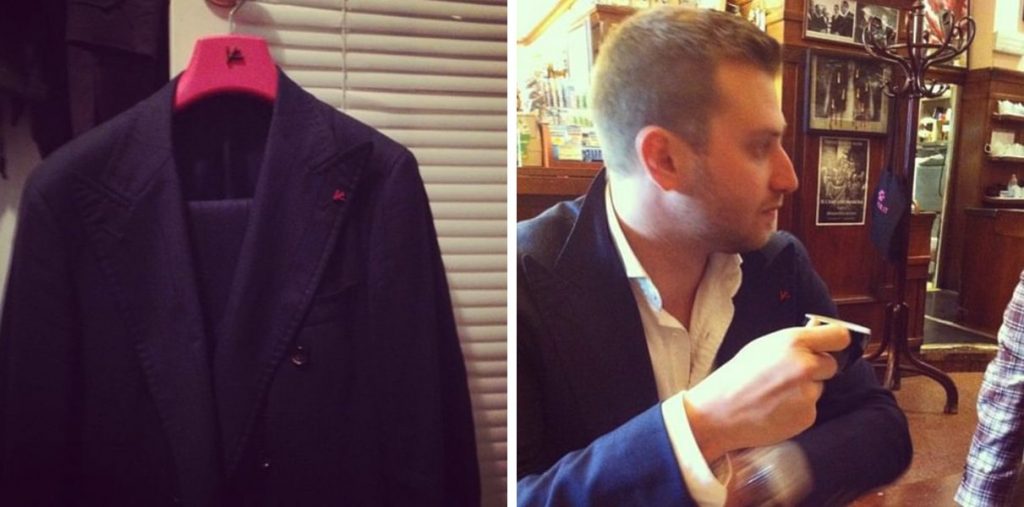
One of the reasons Lawrence loves it so much is how it tastefully straddles the line between conservative and extravagant. The jacket has generously wide lapels, patch pockets, and hand stitching throughout, while the pants have been tailored to have a small break over their two-inch cuffs. “This is not a pedestrian suit,” he elaborates. “Any place I wear that suit, I will have the widest lapels in the room, which is the appeal of Isaia’s Neopolitan tailoring. It’s a navy suit, but it’s also pinstriped.” Lawrence admits it was a risky decision. “To be honest, now that I have the horse blinders off from that period when Italian tailoring was the trend de jour, I’m like, ‘this is a ridiculous suit.’ It’s me dressing like a peacock bozo. Yet, it’s still a navy suit, which as we know, is one of the most foundational pieces any guy can have.”
Lawrence still reaches for it for nights out, fashion events, weddings, and getting dressed up with his wife. “In terms of cost per wear, this is probably the best money I’ve ever spent.” He’s also found that the suit continues to work for him as his style evolves. “For example, I used to never wear boots. I’ve always been more of a loafer guy. But now that I have some boots, I’ve found that this suit works with them. As my style has become more casual, I’ve also worn the suit with shredded Wrangler shirts. That’s not something I would have ever done in the past. I guess that’s the calling card: no matter how I’m feeling, what I’m wearing, or what crazy trend I may be dipping my toes into, this suit somehow still works its way in.”
Lawrence offers advice for people trying to find ways to mix old pieces of clothing into their current aesthetic. “I think it’s just about being passionate and enthusiastic about getting dressed. People get too in their head with stuff like, ‘where do I find references or get inspired?’ As for me, I love clothes, and I love getting dressed. Maybe it’s a shameless lack of self-awareness or something. But for me, I never think twice. That’s why I’ve bricked as many fits as fits I’ve gotten off, and that’s fine. I like trying new combinations, rediscovering old things, and pairing the new with the old. I also find myself in phases where I’m into a certain uniform, or I get something that I love, and my initial instinct is to wear it into the ground. These things aren’t mutually exclusive. I don’t think you have to be fixed to one mindset.”
“You add and subtract, and it’s a journey. That’s what personal style is about for me. I know many people love to be like, ‘yo, I’m locked in. I’ve found my sweet spot.’ My sweet spot is always a moving target. I’ve ebbed and flowed, left things behind, and gone back to them. I spend a lot of time thinking about clothes, looking at clothes, and thinking about how fashion intersects with my other interests, such as music and movies. I’m always paying attention to how people dress, and I’m not afraid to try new things. That’s a long-winded way of saying: ‘I don’t have advice for you. Good luck, dog, and don’t overthink it.'”







